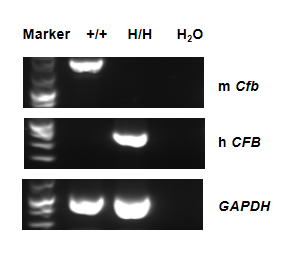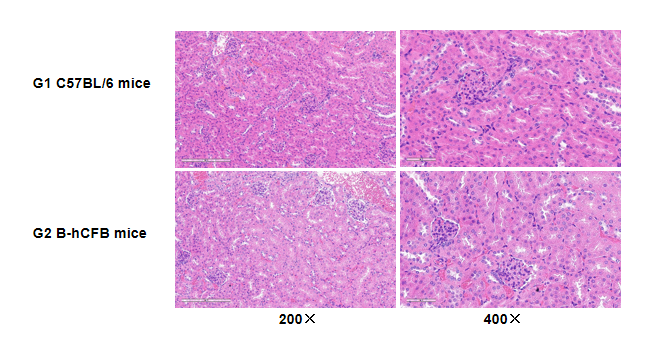| Strain Name |
C57BL/6-Cfbtm1(CFB)Bcgen/Bcgen
|
Common Name | B-hCFB mice |
| Background | C57BL/6N | Catalog number |
111006 |
| Aliases |
CFB: BF, FB, BFD, GBG, CFAB, CFBD, PBF2, AHUS4, FBI12, H2-Bf, ARMD14 |
||

Strain specific CFB expression analysis in wild-type C57BL/6 mice and homozygous B-hCFB mice by ELISA. Serum were isolated from wild-type C57BL/6 mice (+/+) and homozygous B-hCFB mice (H/H) and analyzed by ELISA (Abcam, ab137973) with species-specific CFB ELISA kit. Human CFB was exclusively detectable in homozygous B-hCFB mice but not in wild-type mice.

Blood chemistry of B-hCFB mice

H&E staining of B-hCFB mice

H&E staining of B-hCFB mice. Kidney tissues from male C57BL/6 and B-hCFB mice (n=3, 7 week-old) were collected and analyzed for H&E staining. There were no visible lesions in either measurement between C57BL/6 and B-hCFB mice, indicating that the introduction of hCFB in place of its mouse counterpart does not change the health of the kidney.

The inhibitory efficiency of the nucleic acid drugs against human CFB in B-hCFB mice. B-hCFB mice were randomly divided into three groups (n=3/group, 8 weeks old, male). The human CFB targeted siRNA-analog synthesized according to patents (G2 1mpk, G3 3mpk) and G1 PBS were administered to the mice individually. The mice were sacrificed on day 7, the liver tissue and plasma were collected to detect the expression level of human CFB mRNA by qPCR and protein by ELISA . (A) The schematic diagram of experimental processing. (B) The % human CFB protein remaining of B-hCFB mice. (C) The expression of human CFB mRNA in liver. The human CFB in the treatment group (G2, G3) was significantly reduced compared to the control group (G1). Values are expressed as mean ± SEM. Significance was determined by a one-way ANOVA test. ****p < 0.0001.









